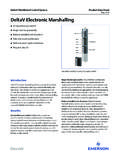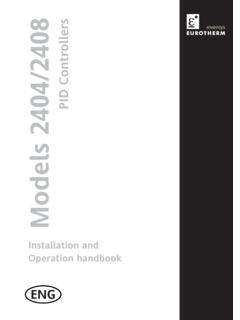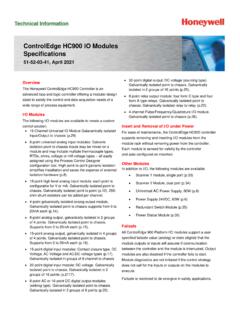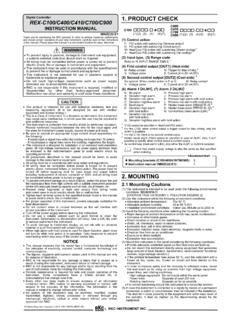Transcription of 1. CALIBRATION OF LVDT TRANSDUCER FOR DISPLACEMENT ...
1 SRI VENKATESWARA COLLEGE OF ENGINEERING AND TECHNOLOGY (AUTONOMUS) ICS Lab manual 1 1. CALIBRATION OF LVDT TRANSDUCER FOR DISPLACEMENT MEASUREMNET Aim: To determine the characteristics of LVDT (linear variable differential transformer). Apparatus required: LVDT, Digital DISPLACEMENT indicator, CALIBRATION jig (with micrometer). Procedure: 1. Plug power chord to AC mains 230 V, 50 Hz and switch on the instrument. 2. Place the READ/CAL switch at READ position. 3. Balance the amplifier with the help of zero knob so that display should read zero ( ) without connecting the LVDT to instrument. 4. Replace the READ/CAL switch at CAL position. 5. Adjust the CALIBRATION point by rotating CAL knob so display should read ie., maximum CALIBRATION range. 6. Again keep the READ/CAL switch at READ position and connect the LVDT cable to instrument.
2 7. Make mechanical zero by rotating the micrometer. Display will read ( ) this is null balancing. 8. Give DISPLACEMENT with micrometer and observe the digital readings. 9. Plot the graph of micrometer reading v/s digital reading. THEORY : LVDT (LINEAR VARIABLE DIFFERENTIAL TRANSFORMER) The most widely used inductive TRANSDUCER to translate the linear motion into electrical signals is the linear variable differential transformer (LVDT). The basic construction of LVDT is shown in fig: Soft iron coreArmSecondary windingPrimary winding The transformer consists of a single primary P and two secondary windings S1 and S2 wound on a cylindrical former. The secondary windings have equal number of turns and are identically placed on either side. A moveable soft iron core is placed inside the transformer.
3 The DISPLACEMENT to be measured is applied to the arm attached to the soft iron core. In practice the arm is made of highly permeability, nickel iron which is hydrogen annealed. This gives low harmonics low null voltage and high sensitivity. This is slotted longitudinally to reduce eddy current losses. The assembly is placed in stainless steel SRI VENKATESWARA COLLEGE OF ENGINEERING AND TECHNOLOGY (AUTONOMUS) ICS Lab manual 2 housing and the end leads provides electrostatic and electromagnetic shielding. The frequency of AC applied to primary windings may be between 50 Hz to 20 kHz. Since the primary winding is excited by an alternating source, it produces an alternating magnetic field which in turn induces alternating current voltage in the two secondary windings.
4 Figure 3 depicts a cross-sectional view of an LVDT. The core causes the magnetic field generated by the primary winding to be coupled to the secondaries. When the core is centered perfectly between both secondaries and the primary, as shown, the voltage induced in each secondary is equal in amplitude and 180 deg out of phase. Thus the LVDT output (for the series-opposed connection shown in this case) is zero because the voltage cancel each other. E0 = Es1 - Es2 = 0 Figure 3. Cross-Sectional View of LVDT Core and Windings Displacing the core to the left (Figure 4) causes the first secondary to be more strongly coupled to the primary than the second secondary. The resulting higher voltage of the first secondary in relation to the second secondary causes an output voltage that is in phase with the primary voltage.
5 Figure 4. Coupling to First Secondary Caused by Associated Core DISPLACEMENT Likewise, displacing the core to the right causes the second secondary to be more strongly coupled to the primary than the first secondary. The greater voltage of the SRI VENKATESWARA COLLEGE OF ENGINEERING AND TECHNOLOGY (AUTONOMUS) ICS Lab manual 3 second secondary causes an output voltage to be out of phase with the primary voltage. Figure 5. Coupling to Second Secondary Caused by Associated Core DISPLACEMENT Tabulation : Micrometer readingIndicated readingModel graph : Micrometer reading Vs Indicated reading Result : Thus the DISPLACEMENT is calibrated by using LVDT Push side readings Pull side readings Micrometer Reading(mm) Indicated reading(mm) Micrometer Reading(mm) Indicated reading(mm) 1 2 3 4 5 6 SRI VENKATESWARA COLLEGE OF ENGINEERING AND TECHNOLOGY (AUTONOMUS) ICS Lab manual 4 2.
6 STUDY AND CALIBRATION OF FORCE CELL WITH FORCE INDICATOR Aim: CALIBRATION of the Force cell. Apparatus required: Force cell, digital force indicators and necessary dead weights. Procedure: 1. Connect the mains chord to the 230 V 50 Hz AC supply. 2. Connect the sensor to the sensor socket provided at the front panel. 3. Switch on the instrument. 4. Put the READ/CAL switch in READ position and set the zero pot to ( balance the bridge). 5. Put the READ/CAL switch in CAL position and check CALIBRATION point that is if not adjust that to with the help of CAL pot. 6. Again put the READ/CAL switch in READ position and apply the load on the sensor. 7. Now the indicator shows the reading 3 digit seven segment display. 8. Plot the graph for applied voltage vs Indicator Reading.
7 Theory : Construction of strain gauge Load cell The main parts of the strain gauge load cell are as follows. They are a cylinder made up of steel on which four identical strain gauge are mounted and out of four strain gauges, two of them (R1 and R4) are mounted along the direction of the applied load(vertical gauges). The other two strain gauges (R2 and R3 Horizontal gauges) are mounted circumferentially at right angles to gauges R1 and R4 SRI VENKATESWARA COLLEGE OF ENGINEERING AND TECHNOLOGY (AUTONOMUS) ICS Lab manual 5 Operation of strain gauge Load cell Let study the operation in two cases Case 1 When there is no load (force) on the steel cylinder, all the four gauges will have the same resistance. As the terminals N and P are at the same potential, the wheat stone bridge is balanced and hence the output voltage will be zero.
8 Case 2 Now the load (force) to be measured (say compression force) is applied on the steel cylinder. Due to this, the vertical gauges R1 and R4 will undergo compression and hence there will be a decrease in resistance. At the same time, the horizontal gauges R2 and R3 will undergo tension and there will be an increase in resistance. Thus when strained, the resistance of the various gauges change. Now the terminal N and P will be at different potential and the change in output voltage due to the applied load (force) becomes a measure of the applied load force when calibrated. Force cell is designed for tensile-compressive (universal type).it has bonded four equal resistance (350 ) stain gauges and are connected in four arm of voltage sensitive bridge.
9 Excitation to the bridge is supplied from load indicator , regulated DC 12V, output of the load cell I is feeding to the highly sophisticated amplifier to the cable corresponding to the force applied on the cell. Amplified output is then converting in analog to digital. This digital output is calibrated to read directly in terms of Kgs with respect to amplified force. Uses of Strain Gauge Load Cell. Strain gauge load cells are used when the load is not steady. Strain gauge load cells are used in vehicle weigh bridges, and tool force dynamometers. SPECIFICATION OF FORCE CELL Type : Tensile Bridge resistance : 350 Bridge excitation : 12 V DC max Material : Stainless steel Indicator Type : Digital Display : Green, seven segment LED CALIBRATION range : 10 Kg Operating voltage : 230 V/50 Hz AC SRI VENKATESWARA COLLEGE OF ENGINEERING AND TECHNOLOGY (AUTONOMUS) ICS Lab manual 6 CONTROLS POWER ON : SPDT switch supplies the AC mains into the indicator.
10 ZERO : 10K 10 turn potentiometer to balance the strain gauge bridge. CALL : 10K single turn potentiometer is to adjust the CALIBRATION point. READ/CAL : 2 position toggle switch to select READ/CAL position. RECORDER : Red and green screw type connecting terminal to measure the analog READ out and recording purpose. SENSOR : 5 pin sockets is provided to connect the sensor cable. POWER CHORD: 3 pin 3 cores interconnect the 230 V -50 Hz. FUSE : 500 mA fuse is used to protect the instrument from the short circuit. Tabulation Applied load (Kgs) Indicated readings (KgF) 1 2 3 4 5 6 Actual Indicated forceACtualapplied loadModel graph: Result : Thus the force cell is calibrated by using digital force cell indicator SRI VENKATESWARA COLLEGE OF ENGINEERING AND TECHNOLOGY (AUTONOMUS) ICS Lab manual 7 3.









